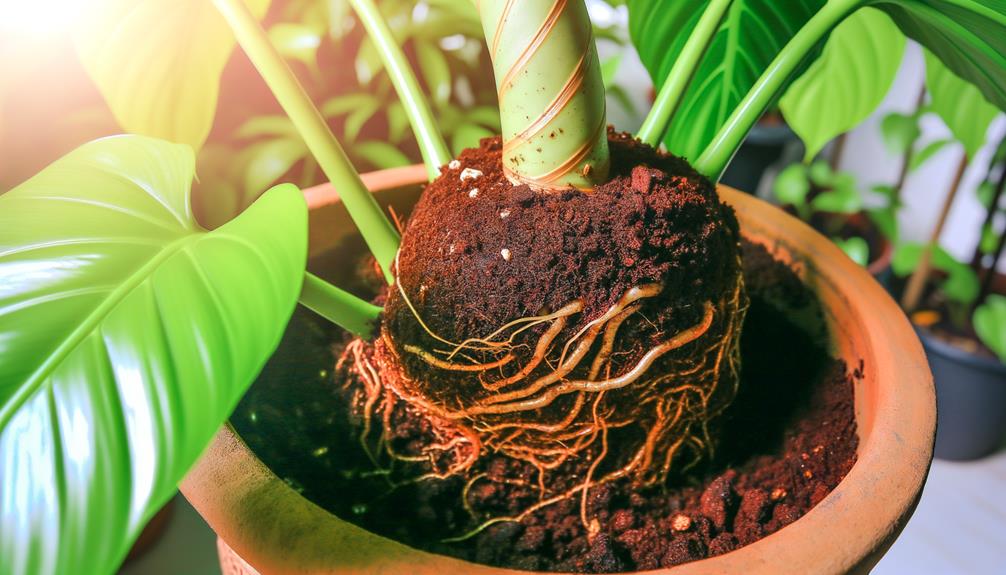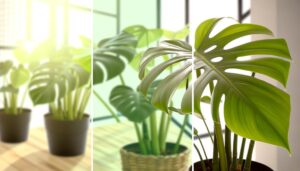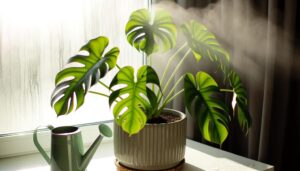How to Care for Monstera Deliciosa
Caring for Monstera Deliciosa requires mimicking its tropical rainforest origins. Position the plant in bright, indirect light and consider supplementary full-spectrum grow lights if natural light is limited.
Maintain a balanced watering schedule, ensuring the top inch of soil dries before re-watering. Use well-draining soil with slightly acidic to neutral pH, enriched with organic material and perlite.
Humidity should range between 60% and 80%, with temperatures from 65°F to 85°F. Fertilize every 4-6 weeks during the growing season with a diluted, balanced formula.
Prune regularly to improve airflow and repot every 1-2 years. Master these basics for thriving Monstera Deliciosa.

Key Takeaways
- Place Monstera Deliciosa in bright, indirect light near an east or north-facing window.
- Water when the top inch of soil is dry using room-temperature, filtered water.
- Maintain humidity levels between 60%-80% and keep temperatures consistent between 65°F and 85°F.
- Use a well-draining soil mix with potting medium, perlite, and peat moss or coco coir.
- Fertilize every 4-6 weeks in the growing season with a diluted balanced fertilizer (20-20-20 N-P-K ratio).
Ideal Light Conditions

Monstera deliciosa thrives best in bright, indirect light, where it can receive ample illumination without the risk of leaf burn from direct sun exposure. This species, native to tropical rainforests, has evolved to grow under the canopy of larger trees, receiving dappled sunlight.
For peak growth, place the plant near an east or north-facing window, ensuring filtered light. Excessive direct sunlight can cause the leaves to develop brown, scorched edges, compromising the plant's health. Conversely, insufficient light may result in leggy growth and smaller leaves, reducing its characteristic fenestrations.
When artificial light is necessary, utilize full-spectrum grow lights to mimic natural conditions. Maintaining these light conditions guarantees robust growth and vibrant foliage, essential for the plant's overall vigor.
Watering Schedule
Proper hydration is essential for Monstera deliciosa, necessitating a balanced watering schedule that aligns with its native tropical environment. This species thrives in consistently moist, but not waterlogged, conditions. Over-watering can lead to root rot, a common issue in improperly drained soil.
Monitor the top inch of the soil; when it feels dry to the touch, it is time to water. Utilize room-temperature, filtered water to avoid chlorine and fluoride toxicity. During the growing season (spring to early autumn), water more frequently, approximately once a week.
In contrast, reduce watering during the dormant period in winter, allowing the soil to dry out slightly more between waterings. Employing a moisture meter can provide precise readings, ensuring ideal hydration.
Soil Requirements

Monstera deliciosa thrives in a soil mix that balances organic matter with adequate drainage to prevent root rot.
A well-aerated substrate is vital, often achieved with a blend of peat moss, perlite, and pine bark.
Additionally, maintaining a slightly acidic to neutral pH range of 5.5 to 7.0 optimizes nutrient availability and plant health.
Ideal Soil Composition
To achieve ideal development, Monstera deliciosa requires a well-draining soil mixture rich in organic matter and slightly acidic to neutral pH levels. The best soil composition includes a blend of various components to ensure proper nutrient availability, moisture retention, and aeration. A recommended mixture consists of one part potting medium, one part perlite, and one part peat moss or coco coir. This combination provides both the necessary organic substances and structural stability for root development.
| Component | Function | Ratio |
|---|---|---|
| Potting Medium | Base substrate, nutrient-rich | 1 part |
| Perlite | Improves drainage, prevents compaction | 1 part |
| Peat Moss/Coco Coir | Maintains moisture, offers organic material | 1 part |
This soil blend supports Monstera deliciosa's growth by maintaining a balanced environment.
Drainage and Aeration Importance
Promoting sufficient drainage and aeration is crucial for preventing root rot and fostering healthy root growth in Monstera deliciosa. Proper drainage allows excess water to escape, reducing the risk of waterlogged soil conditions that can lead to root rot caused by pathogenic fungi.
Introducing perlite, pumice, or coarse sand into the soil mix improves aeration by creating air pockets that facilitate oxygen exchange around the roots. This is vital for cellular respiration and nutrient uptake.
In addition, choosing a well-draining pot with ample drainage holes ensures that water flows freely out of the container, further reducing the potential for stagnation.
Regularly monitoring the soil moisture and adjusting watering practices accordingly can also help maintain ideal conditions for root health.
Ph Level Preferences
Maintaining a soil pH between 5.5 and 7.0 is crucial for maximizing nutrient availability and promoting ideal growth conditions for Monstera deliciosa. This pH range guarantees that key nutrients such as nitrogen, phosphorus, and potassium remain bioavailable, facilitating best plant health.
Soils that deviate significantly from this range can lead to nutrient lockout, where essential minerals become chemically inaccessible to the plant roots. Regular testing of soil pH using a reliable pH meter is recommended to ensure consistency.
Should adjustments be necessary, sulfur or aluminum sulfate can lower soil pH, while lime or wood ash can raise it. By maintaining the appropriate pH level, cultivators can guarantee that Monstera deliciosa receives the nourishment it requires for vigorous growth and lush foliage.
Humidity and Temperature
Maintaining appropriate humidity and temperature levels is essential for the healthy growth of Monstera Deliciosa.
This tropical plant thrives in humidity levels between 60% and 80%, and prefers an ideal temperature range of 65°F to 85°F.
Ensuring these conditions can greatly enhance the plant's physiological processes, promoting robust foliage and overall vitality.
Ideal Humidity Levels
Monstera Deliciosa thrives in environments where the humidity levels are consistently kept between 60% and 80%, accompanied by temperatures ranging from 65°F to 85°F.
Sufficient humidity is crucial for the plant's physiological processes, including transpiration and nutrient uptake. In conditions of low humidity, Monstera may show symptoms such as browning leaf edges and stunted growth.
To increase humidity, consider using a humidifier or placing the plant on a tray filled with water and pebbles, securing the pot's base stays dry. Another effective method is misting the leaves regularly, though this should be done in the morning to prevent fungal growth.
Monitoring humidity with a hygrometer can ensure ideal conditions are consistently maintained.
Optimal Temperature Range
The Monstera Deliciosa thrives best in a temperature range of 65°F to 85°F, where its metabolic activities are optimized for growth and development. In this range, enzymatic processes and cellular functions are efficiently carried out, promoting healthy foliage and strong root systems.
It's important to avoid temperatures below 55°F, as cold stress can inhibit growth and lead to cellular damage. Additionally, maintaining a consistent temperature without sudden fluctuations is crucial to prevent physiological stress.
Humidity levels should complement the temperature, ideally between 60% and 80%, to mimic the plant's native tropical environment. Proper regulation of both temperature and humidity guarantees the Monstera Deliciosa remains vibrant, with characteristic fenestrated leaves and a strong structural integrity.
Fertilizing Tips

Providing your Monstera Deliciosa with the appropriate nutrients is essential for its robust growth and vibrant foliage. Utilize a balanced, water-soluble fertilizer with an N-P-K ratio of 20-20-20, administered every 4-6 weeks during the growing season (spring and summer).
Dilute the fertilizer to half-strength to prevent root burn. Organic options, such as liquid seaweed or fish emulsion, can also be effective, promoting soil health and microbial activity.
During the dormant period (fall and winter), reduce fertilization frequency to avoid overstimulation. Monitor the plant for signs of nutrient deficiencies, such as yellowing leaves, which may indicate the need for a micronutrient supplement.
Ensuring proper fertilization will enhance the plant's vigor and aesthetic appeal.
Pruning and Repotting
Effective plant maintenance requires regular pruning and timely repotting to achieve the best growth and health of your Monstera Deliciosa. Pruning involves removing dead or yellowing leaves, which enhances airflow and light penetration, promoting healthier growth. Use sterilized scissors to cut just above a node. Repotting should be done every 1-2 years to refresh the soil and provide space for root expansion. Select a pot that is 2 inches larger in diameter than the current one and use well-draining soil.
| Task | Frequency |
|---|---|
| Pruning | As needed |
| Repotting | Every 1-2 years |
| Soil Refresh | Every repotting |
Conclusion
The juxtaposition of Monstera deliciosa's lush greenery and the precision needed for its care underscores the plant's dual nature of beauty and need.
Securing ideal light, adhering to a strict watering schedule, maintaining suitable soil, and controlling humidity and temperature are crucial.
Paired with strategic fertilizing and occasional pruning and repotting, these practices support robust growth.
The combination of these factors mirrors the scientific complexities of horticulture and the careful attention required for flourishing Monstera deliciosa.






